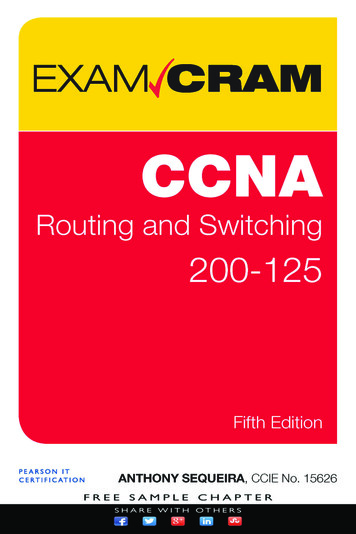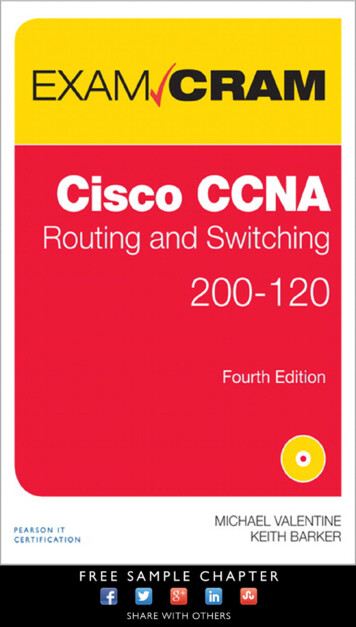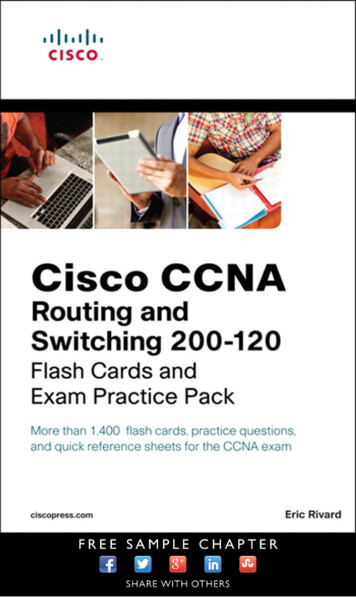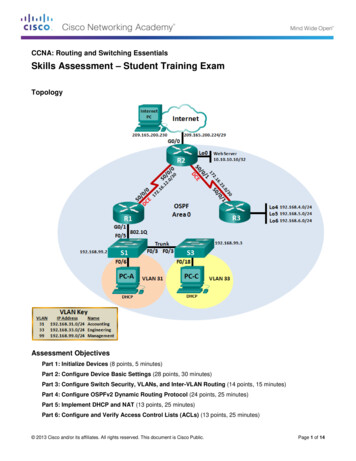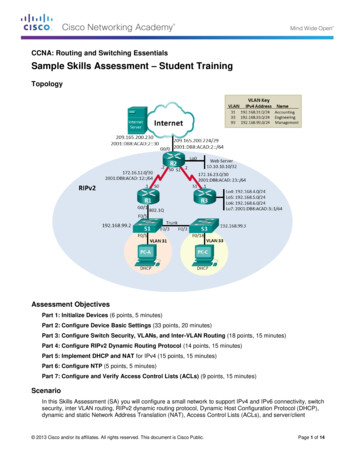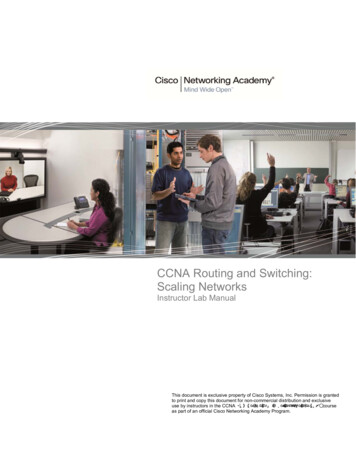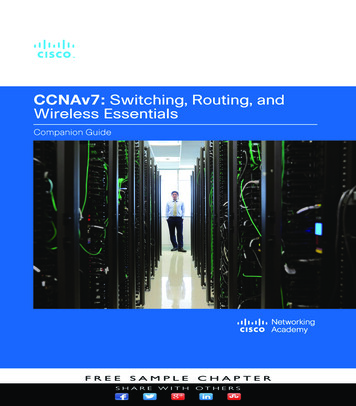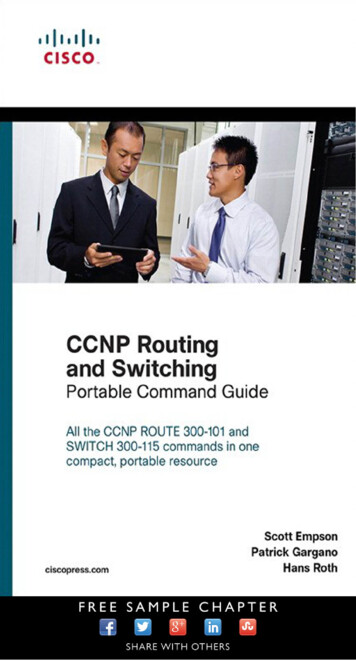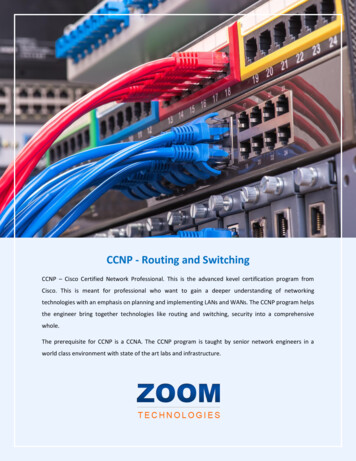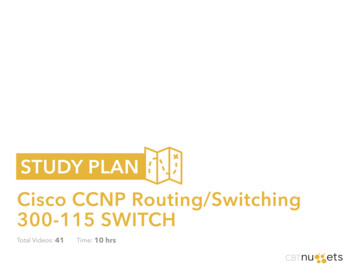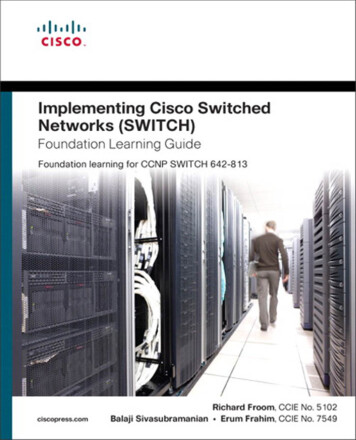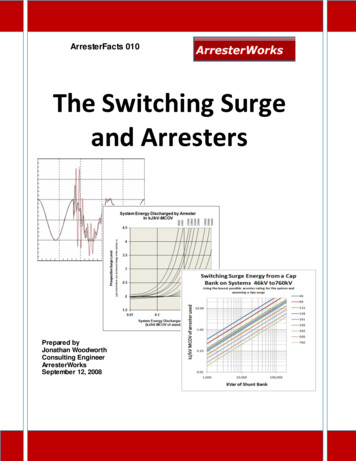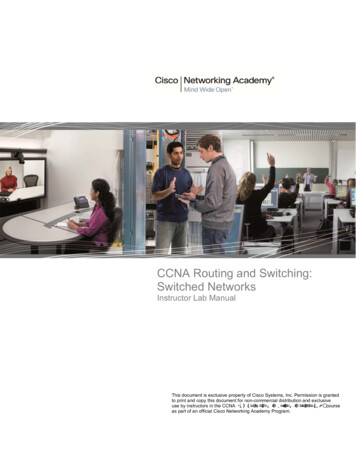
Transcription
CCNA Routing and Switching:Switched NetworksInstructor Lab ManualThis document is exclusive property of Cisco Systems, Inc. Permission is grantedto print and copy this document for non-commercial distribution and exclusiveuse by instructors in the CCNA 5RXWLQJ DQG 6ZLWFKLQJ 6ZLWFKHG 1HWZRUNV courseas part of an official Cisco Networking Academy Program.
Sent or Received (Instructor Version)Instructor Note: Red font color or Gray highlights indicate text that appears in the instructor copy only.ObjectivesDescribe convergence of data, voice, and video in the context of switched networks.Students will be able to explain how switches can help LAN end devices send and receive data, voice, and videodata.ScenarioIndividually, or in groups (per the instructor’s decision), discuss various ways hosts send and receive data,voice, and streaming video. Develop a matrix (table) listing network data types that can be sent and received. Provide five examples.Your matrix table might look something like this:SentClient requests a web pagefrom a web server.ReceivedWeb server send web pageto requesting client.Save your work in either hard- or soft-copy format. Be prepared to discuss your matrix and statements in aclass discussion.ResourcesInternet connectivityReflection1. If you are receiving data, how do you think a switch assists in that process?Students should mention that switches process data to and from end devices - many users can be sending andreceiving data at the same time.2. If you are sending network data, how do you think a switch assists in that process?Switches allow multiple recipients to send and receive data simultaneously. Compared to hubs, a switch allowsfor better used of the bandwidth. 2013 Cisco and/or its affiliates. All rights reserved. This document is Cisco Public.Page 1 of 2
Sent or ReceivedMatrix Answers (will vary)Instructor Note: This is a representative model that might be “built” as a result of this activity:SentReceivedClient requests a web page from a webserver.Automatic updates to your cell telephone applicationsWeb server send web page to requesting client.Client requests a file from a FTP server.FTP server sends the requested file to the client.Client requests a streaming video from aserver.Server transmits video to requesting clients.Bob sends instant message to Mary.Mary receives instant from Bob.Ethernet switch receives an Ethernet frameon ingress port 1.Ethernet switch forwards frame out egress port 4.Bob sends VoIP packets from his IP phone.Mary receives VoIP packets on her IP phone. 2013 Cisco and/or its affiliates. All rights reserved. This document is Cisco Public.Page 2 of 2
Lab – Selecting Switching Hardware (Instructor Version)Instructor Note: Red font color or Gray highlights indicate text that appears in the instructor copy only.ObjectivesPart 1: Explore Cisco Switch ProductsPart 2: Select an Access Layer SwitchPart 3: Select a Distribution/Core Layer SwitchBackground / ScenarioAs a Network Engineer, you are part of a team that selects appropriate devices for your network. You need toconsider the network requirements for the company as they migrate to a converged network. This convergednetwork supports voice over IP (VoIP), video streaming, and expansion of the company to support a largercustomer base.For a small- to medium-sized company, Cisco hierarchical network design suggests only using a two-tier LANdesign. This design consists of an access layer and a collapsed core/distribution layer. Network switchescome in different form factors, and with various features and functions. When selecting a switch, the teammust choose between fixed configuration or modular configuration, and stackable or non-stackable switches.Based on a given set of requirements, you will identify the Cisco switch models and features to support therequirements. The scope of this lab will limit the switch models to campus LAN only.Required ResourcesPC with Internet accessPart 1: Explore Cisco Switch ProductsIn Part 1, you will navigate the Cisco website and explore available switch products.Step 1: Navigate the Cisco website.At www.cisco.com, a list of available products and information about these products is available.a. From the home page, click Products & Services Switches.Step 2: Explore switch products.In the Feature Products section, a list of different categories of switches is displayed. In this lab, you willexplore the campus LAN switches. You can click different links to gather information about the different switchmodels. On this page, the information is organized in different ways. You can view all available switches by 2013 Cisco and/or its affiliates. All rights reserved. This document is Cisco Public.Page 1 of 5
Lab – Selecting Switching Hardwareclicking View All Switches. If you click Compare Series, the switches are organized by types: modular vs.fixed configuration.a. Click the heading Campus LAN – Core and Distribution Switches.List a few models and some of features in the table below.ModelCatalyst 4500-XCatalyst 4500EUplink Speed8 x 10 GE (hotswap module)1G or 10GNumber ofPorts/SpeedOther FeaturesUp to 40 1G/10G portshot swappable powersupplies, cooling fans andnetwork modules, 1 RU,QoS, Fixed configurationUp to 196 1G ports andup to 100 10G portsPoE , hot swappable powersupplies, cooling fans andnetwork modules, Modularconfigurationb. Click the heading Campus LAN – Access Switches.List a few models and some of features in the table below. 2013 Cisco and/or its affiliates. All rights reserved. This document is Cisco Public.Page 2 of 5
Lab – Selecting Switching HardwareModelCatalyst 2960Catalyst 3560-Xand 3750-Xc.Uplink Speed2x1GE uplink4x1GE or 10GEuplink ports(optional)Number ofPorts/SpeedOther Features8, 24, and 48 FE portsPoE , advanced QoS, ratelimiting, ACLs, IPv6,multicast, Fixedconfiguration12, 24, and 48 FE/GEportsQoS, PoE , hot swappablepower supplies, cooling fansand network modules,StackPower and StackWise,Fixed configurationClick the heading Campus LAN – Compact Switches.List a few models and some of features in the table below.ModelCatalyst 3560-CCatalyst 2960-CUplink Speed2x1GE uplink2x1GE uplinkNumber of Ports/SpeedOther Features8-12 FE/GE portsCollocate with users,PoE , Fixed configuration8-12 FE/GE portsCollocate with users, PoE/ PoE pass-through, FixedconfigurationPart 2: Select an Access Layer SwitchThe main function of an access layer switch is to provide network access to end user devices. This switchconnects to the core/distribution layer switches. Access switches are usually located in the intermediatedistribution frame (IDF). An IDF is mainly used for managing and interconnecting the telecommunicationscables between end user devices and a main distribution frame (MDF). There are typically multiple IDFs withuplinks to a single centralized MDF.An access switch should have the following capabilities: low cost per switch port, high port density, scalableuplinks to higher layers, and user access functions and resiliency. In Part 2, you will select an access switchbased on the requirements set by the company. You have reviewed and become familiar with Cisco switchproduct line. 2013 Cisco and/or its affiliates. All rights reserved. This document is Cisco Public.Page 3 of 5
Lab – Selecting Switching Hardwarea. Company A requires a replacement access switch in the wiring closet. The company requires the switchto support VoIP and multicast, accommodate future growth of users and increased bandwidth usage. Theswitch must support a minimum of 35 current users and have a high-speed uplink. List a few of modelsthat meet those requirements.Answers will vary. 2960-S or 3560-X with 48 port capacity and at least two 1G/10G uplinksb. Company B would like to extend services to a conference room on an as-needed basis. The switch will beplaced on the conference room table, and switch security is a priority.Answers will vary. A Compact LAN switch such as the 2960-CPart 3: Select a Distribution/Core Layer SwitchThe distribution/core switch is the backbone of the network for the company. A reliable network core is ofparamount importance for the function of the company. A network backbone switch provides both adequatecapacity for current and future traffic requirements and resilience in the event of failure. They also require highthroughput, high availability, and advanced quality of service (QoS). These switches usually reside in themain wiring closet (MDF) along with high speed servers, routers, and the termination point of your ISP. 2013 Cisco and/or its affiliates. All rights reserved. This document is Cisco Public.Page 4 of 5
Lab – Selecting Switching Hardwarea. Company C will replace a backbone switch in the next budget cycle. The switch must provide redundancyfeatures to minimize possible downtime in the event that an internal component fails. What features canaccommodate these requirements for the replacement switch?Answers will vary. Hotswappable power supplies, cooling fans and network modules, redundant powersupplies, StackWise and StackPowerb. Which Cisco Catalyst switches would you recommend?Answers will vary.3750-X, 4500-X, 4500-Ec.As Company C grows, high speed, such as 10 GB Ethernet, up to 8 uplink ports, and a modularconfiguration for the switch will become necessary. Which switch models would meet the requirement?Answers will vary. 4500, 6500ReflectionWhat other factors should be considered during the selection process aside from network requirements andcosts?Space/form factor, power consumption, modular upgrade, longevity of switch, IOS features for the switch 2013 Cisco and/or its affiliates. All rights reserved. This document is Cisco Public.Page 5 of 5
It’s Network Access Time (Instructor Version)Instructor Note: Red font color or Gray highlights indicate text that appears in the instructor copy only.ObjectivesDescribe features available for switches to support requirements of a small- to medium-sized businessnetwork.Students will design two networks using Packet Tracer to suffice requirements shown in a LAN and WANscenarios.ScenarioUse Packet Tracer for this activity. Work with a classmate to create two network designs to accommodate thefollowing scenarios:Scenario 1 – Classroom Design (LAN) 15 student end devices represented by 1 or 2 PCs. 1 instructor end device; a server is preferred. Device capability to stream video presentations over LAN connection. Internet connectivity is not requiredin this design.Scenario 2 – Administrative Design (WAN) All requirements as listed in Scenario 1. Add access to and from a remote administrative server for video presentations and pushed updates fornetwork application software.Both the LAN and WAN designs should fit on to one Packet Tracer file screen. All intermediary devicesshould be labeled with the switch model (or name) and the router model (or name).Save your work and be ready to justify your device decisions and layout to your instructor and the class.Reflection1. What are some problems that may be encountered if you receive streaming video from your instructor’sserver through a low-end switch?Answers will vary – bandwidth might be too low for the video stream to many recipients causing lag time –distortion may result in picture, audio, etc. Some stations could be “kicked out” as a result of traffic overloaddepending on the application program being used to stream the video, etc. There is also the possibility of “sniffingor snooping” depending on how the switch is configured.2. How would the traffic flow be determined: multicast or broadcast – in transmission?When users have to “log in” to the application to receive the video transmission, this would be considered amulticast. If students are set up collectively into a group by the server to push the stream, it would be considereda broadcast on the LAN side.3. What would influence your decision on the type of switch to use for voice, streaming video and regular datatransmissions? 2013 Cisco and/or its affiliates. All rights reserved. This document is Cisco Public.Page 1 of 2
It’s Network Access TimeAnswers will vary – if the switch will be also used for WAN streams and other intensive download traffic, a higherlevel switch would be used.4. As you learned in the first course of the Academy, video and voice use a special TCP/IP model, transportlayer protocol. What protocol is used in this layer and why is it important to voice and video streaming?(UDP is the protocol used for voice and video – it allows for a continuous stream of data to flow withoutinterruption to report delays back to the sender. There is no guaranteed delivery of data from source todestination hosts)Packet Tracer Example (answers will vary)Instructor Note: This is a representative model that might be “built” as a result of this activity:Identify elements of the model that map to IT-related content: Voice, video and regular data can traverse networks using different devices, such as routers andswitches. The type of switch that is used as an intermediary device provides different functional capacities. The type of network traffic will impact the switch’s performance in sending and delivering data. Sufficient bandwidth is necessary to handle different types of traffic; therefore, network switchtypes/models and their capabilities are important to the switch model and type. Security impacts the switch selection. If the switch will be accessible physically, remotely or over thenetwork locally, it will need to have security configured to include ACLs and/or port security. 2013 Cisco and/or its affiliates. All rights reserved. This document is Cisco Public.Page 2 of 2
Stand By Me (Instructor Version)Instructor Note: Red font color or Gray highlights indicate text that appears in the instructor copy only.ObjectiveDescribe the role of unicast, broadcast, and multicast in a switched network.Instructor Notes: Students are given three scenarios where activity-based numbers wil
CCNA Routing and Switching: Switched Networks Instructor Lab Manual This document is exclusive property of Cisco Systems, Inc. Permission is granted to print and copy this document for non-commercial distribution and exclusive use by instructors in the CCNA 5RXWLQJ DQG 6ZLWFKLQJ 6ZLWFKHG 1HWZRUNV course
